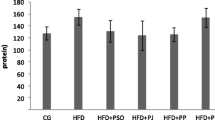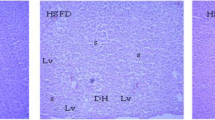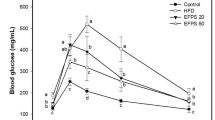Abstract
Obesity is related to an elevated risk of dementia and the physiologic mechanisms whereby fat adversely affects the brain are poorly understood. The present investigation analyzed the effect of a high fat diet (HFD) on brain steatosis and oxidative stress and the intracellular mediators involved in signal transduction, as well as the protection offered by grape seed and skin extract (GSSE). HFD induced ectopic deposition of cholesterol and phospholipid but not triglyceride. Moreover brain lipotoxicity is linked to an oxidative stress characterized by increased lipoperoxidation and carbonylation, inhibition of glutathione peroxidase and superoxide dismutase activities, depletion of manganese and a concomitant increase in ionizable calcium and acetylcholinesterase activity. Importantly GSSE alleviated all the deleterious effects of HFD treatment. Altogether our data indicated that HFD could find some potential application in the treatment of manganism and that GSSE should be used as a safe anti-lipotoxic agent in the prevention and treatment of fat-induced brain injury.





Similar content being viewed by others
References
Waldstein SR, Katzel LI (2006) Interactive relations of central versus total obesity and blood pressure to cognitive function. Int J Obes (Lond) 30:201–207
Unger RH, Orci L (2002) Lipoapoptosis: its mechanism and its diseases. Biochim Biophys Acta 1585:202–212
Bruce-Keller AJ, Keller JN, Morrison CD (2009) Obesity and vulnerability of the CNS. Biochim Biophys Acta 1792:395–400
Zhang X, Dong F, Ren J et al (2005) High dietary fat induces NADPH oxidase-associated oxidative stress and inflammation in rat cerebral cortex. Exp Neurol 191:318–325
Liu J, Head E, Gharib AM et al (2002) Memory loss in old rats is associated with brain mitochondrial decay and RNA/DNA oxidation: partial reversal by feeding acetyl-L-carnitine and/or R alpha- lipoic acid. Proc Natl Acad Sci USA 99:2356–2361
Mattson MP, Duan W, Guo Z (2003) Meal size and frequency affect neuronal plasticity and vulnerability to disease: cellular and molecular mechanisms. J Neurochem 84:417–431
Tyurin VA, Tyurina YY, Borisenko GG et al (2000) Oxidative stress following traumatic brain injury in rats : quantitation of biomarkers and detection of free radical intermediates. J Neurochem 75:2178–2189
Sun AY, Wang Q, Simonyi A, Sun GY (2010) Resveratrol as a therapeutic agent for neurodegenerative diseases. Mol Neurobiol 41:375–383
Bagchi D, Bagchi M, Stohs SJ et al (2002) Cellular protection with proanthocyanidins derived from grape seeds. Ann N Y Acad Sci 957:260–270
Abd El-Wahab AE, El-Adawi H, Sh kassem H (2008) Towards understanding the hepatoprotective effect of grape seeds extract on cholesterol-fed rats. Aust J Basic and Appl Sci 2:412–417
Pataki T, BakI Kovacs P, Bagchi D et al (2002) Grape seed proanthocyanidins improved cardiac recovery during reperfusion after ischemia in isolated rat hearts. Am J Clin Nutr 75:894–899
Saad A, Youssef Mokhtar I, El-Shennawy Lamia K (2009) Cisplatin induced damage in kidney genomic DNA and nephrotoxicity in male rats: The protective effect of grape seed proanthocyanidin extract. Food Chem Toxicol 47:1499–1506
Hwang IK, Yoo KY, Kim DS et al (2004) Neuroprotective effects of grape seed extract on neuronal injury by inhibiting DNA damage in the gerbil hippocampus after transient forebrain ischemia. Life Sci 75:1989–2001
Devi A, Jolitha AB, Ishii N (2006) Grape seed proanthocyanidin extract (GSPE) and antioxidant defense in the brain of adult rats. Med Sci Monit 12:124–129
Du Y, Guo H, Lou H (2007) Grape seed polyphenols protect cardiac cells from apoptosis via induction of endogenous antioxidant enzymes. J Agric Food Chem 55:1695–1701
Bagchi D, Bagchi M, Stohs SJ et al (2000) Free radicals and grape seed proanthocyanidin extract: importance in humain health and disease prevention. Toxicology 148:187–197
Ferruzzi MG, Lobo JK, Janle EM et al (2009) Bioavailability of gallic acid and catechins from grape seed polyphenol extract is improved by repeated dosing in rats: implications for treatment in Alzheimer’s disease. J Alzheimers Dis 18:113–124
Constant J (1997) Alcohol, ischemic heart disease, and the French Paradox. Clin Cardiol 20:420–424
FDA agency response letter GRAS notice no GRN000124, http//www.fda.gov/Food/FoodingredientsPackaging/GenerallyRecognizedasSafeGRAS/GRASListings/ucm153940;htm, Accessed 1 June 2011
Singleton VL, Rossi J (1965) Colorimetry of total phenolics with phospho-molybdic-phosphotungstic acid reagents. Am J Enol Vitic 16:144–158
Dewanto V, Wu X, Adom KK et al (2002) Thermal processing enhance the nutritional value of tomatoes by increasing total antioxidant activity. J Agric Food Chem 50:3010–3014
Sun B, Richardo da Silva JM, Spranger I (1998) Critical factors of vanillin assay for catechin and proanthocyanidins. J Agric Food Chem 46:4267–4274
National Research council (1985) Guide for the care and the use of laboratory animals, vol 20. National Institute of Health, Bethesda, pp 85–123
Folch J, Lees M, Sloane Stanley GH (1957) A simple method for the isolation and purification of total lipids from animal tissues. J Biol Chem 226:497–509
Draper HH, Hadley M (1990) Malondialdehyde determination as index of lipid peroxidation. Methods Enzymol 186:421–431
Levine RL, Garland D, Oliver CN et al (1990) Determination of carbonyl content in oxidatevely modified proteins. Method Enzymol 186:467–478
Hartree EF (1972) Determination of protein: a modification of the Lowry method that gives a linear photometric response. Anal Biochem 48:422–427
Ellman G (1959) Tissue sulfhydryl groups. Arch Biochem Biophys 82:70–77
Nakamura W, Hosoda S, Hayashi K (1974) Purification and properties of rat liver glutathione peroxidase. Biochim Biophys Acta 358:251–261
Aebi H (1974) Methods of enzymatic analysis, 2e edn. Chemia Weinheium, NewYork
Misra HP, Fridovich I (1972) The role of superoxide anion in the autoxidation of epinephrine and a simple assay for superoxide dismutase. J Biol Chem 247:3170–3175
Ellman GE, Courtney KD, Andres V Jr et al (1961) A new and rapid colorimetric determination of acetylcholinesterase activity. Biochem Pharmacol 7:88–95
Santoro JC, Harris G, Sitlani A (2001) Colorimetric detection of glutamine synthetase-catalyzed transferase activity in glucocorticoid-treated skeletal muscle cells. Anal Biochem 289:18–25
Stern J, Lewis WH (1957) The colorimetric estimation of calcium in serum with ocresolphthalein complex one. Clin Chim Acta 2:576–580
Kakinuma K, Yamaguchi T, Kaneda M et al (1979) A determination of H2O2 release by the treatment of human blood polymorphonuclear leucocytes with myristate. J Biochem 86:87–95
Green LC, Wagner DA, Glogowski J et al (1982) Analysis of nitrate, nitrite and [15 N] nitrate in biological fluids. Anal Biochem 126:131–138
Buettner R, Parhofer KG, Woenckhaus M et al (2006) Defining high-fat-diet rat models: metabolic and molecular effects of different fat types. J Mol Endocrinol 36:485–501
Charradi K, Sebai H, Elkahoui S et al (2011) Grape seed extract alleviates high-fat diet-induced obesity and heart dysfunction by preventing cardiac siderosis. Cardiovasc Toxicol 11:28–37
Urayama A, Banks WA (2008) Starvation and triglycerides reverse the obesity-Induced impairment of insulin transport at the blood-brain barrier. Endocrinology 149:3592–3597
Leduc V, Jasmin-Bélanger S, Poirier J (2010) APOE and cholesterol homeostasis in Alzheimer’s disease. Trends Mol Med 16:469–477
Marcin F, Tomasz S (2005) Biochemical markers and risk factors of Alzheimer’s Disease. Curr Alzheimer Res 2:47–64
Li G, Larson EB, Sonnen JA et al (2007) Statin therapy is associated with reduced neuropathologic changes of Alzheimer disease. Neurology 69:878–885
Haag MD, Hofman A, Koudstaal PJ et al (2009) Statins are associated with a reduced risk of Alzheimer disease regardless of lipophilicity. The Rotterdam Study. J Neurol Neurosurg Psychiatry 80:13617
Ma D, Lu L, Boneva NB et al (2008) Expression of free fatty acid receptor GPR40 in the neurogenic niche of adult monkey hippocampus. Hippocampus 18:326–333
Patil S, Chan C (2005) Palmitic and stearic fatty acids induce Alzheimer-like hyperphosphorylation of tau in primary rat cortical neurons. Neurosci Lett 384:288–293
Hernandez EH, Discalzi G, Valentini C et al (2006) Follow-up of patients affected by Mn-induced Parkinsonism after treatment with CaNa(2)EDTA. NeuroToxicol 27:333–339
Zheng W, Jiang Y-M, Zhang Y et al (2009) Chelation therapy of manganese intoxication with para-aminosalicyclic acid (PAS) in Sprague-Dawley rats. NeuroToxicol 30:240–248
Eid T, Behar K, Dhaher R et al (2012) Roles of glutamine synthetase inhibition in epilepsy. Neurochem Res. doi:10.1007/s11064-012-0766-5
Yokel RA (2009) Manganese flux across the blood-brain barrier. Neuromolecular Med 11:297–310
Yin Z, Jiang H, Lee ESY et al (2010) Ferroportin is a manganese responsive protein that decreases manganese cytotoxicity and accumulation. J Neurochem 112:1190–1198
Santos D, Milatovic D, Andrade V et al (2012) The inhibitory effect of manganese on acetylcholinesterase activity enhances oxidative stress and neuroinflammation in the rat brain. Toxicology 292:90–98
Toborek M, Malecki A, Garrido R et al (1999) Arachidonic acid- induced oxidative injury to cultured spinal cord neurons. J Neurochem 73:684–692
Campiani G, Fattorusso C, De Angelis M et al (2003) Neuronal high-affinity sodium dependent glutamate transporters (EAATs): Targets for the developement of novel therapeutics against neurodegenerative diseases. Curr Pharm Des 9:595–625
Dalia Y, Singh N, Jaqqi AS et al (2010) Memory restorative role of statins in experimental dementia: an evidence of their cholesterol dependent and independent actions. Pharmacol Rep 62:784–796
Carl GF, Blackwell LK, Barnett FC et al (1993) Manganese and epilepsy: brain glutamine synthetase and liver arginase activities in genetically epilepsy prone and chronically seizured rats. Epilepsia 34:441–446
Simeone KA, Sabesan S, Kim DY et al (2011) L-type calcium channel blockade reduces network activity in human epileptic hypothalamic hamartoma tissue. Epilepsia. doi:10.1111/j.1528-1167.2010.02942.x
Catterall WA (2000) structure and regulation of voltage-gated calcium channels. Annu Rev Cell Dev Biol 16:521–555
Bagchi D, Ray SD, Patel D et al (2001) Protection against drug and chemical-induced multiorgan toxicity by a novel IH636 grape seed proanthocyanidin extract. Drugs Exp Clin Res 27:3–15
Nassiri Asl M, Hosseinzadeh H (2009) Review of the pharmacological effects of Vitis Vinifera (grape) and its bioactive compounds. Phytotherapy Res 23:1197–1204
Rahvar M, Nikseresht M, Shafiee SM et al (2011) Effect of oral resveratrol on the BDNF gene expression in the hippocampus of the rat brain. Neurochem Res 36:761–765
Ahmad A, Khan MM, Hoda MN et al (2011) Quercetin protects against oxidative stress associated damages in a rat model of transient focal cerebral ischemia and reperfusion. Neurochem Res 36:1360–1371
Filomeni G, Graziani I, De Zio D et al (2012) Neuroprotection of kaempferol by autophagy in models of rotenone-mediated acute toxicity: possible implications for parkinson’s disease. Neurobiol Aging 33:767–785
Narita K, Hisamoto M, Okuda T et al (2011) Differential neuroprotective activity of two different grape seed extracts. PlosOne 6:1–10
Selma MV, Freitas PM, Almela L et al (2008) Ultraviolet-C and induced stilbenes control ochratoxigenic aspergillus in grapes. J Agric Food Chem 56:9990–9996
Conflict of interest
The authors declare that there are no conflicts of interest.
Author information
Authors and Affiliations
Corresponding author
Rights and permissions
About this article
Cite this article
Charradi, K., Elkahoui, S., Karkouch, I. et al. Grape Seed and Skin Extract Prevents High-Fat Diet-Induced Brain Lipotoxicity in Rat. Neurochem Res 37, 2004–2013 (2012). https://doi.org/10.1007/s11064-012-0821-2
Received:
Revised:
Accepted:
Published:
Issue Date:
DOI: https://doi.org/10.1007/s11064-012-0821-2




